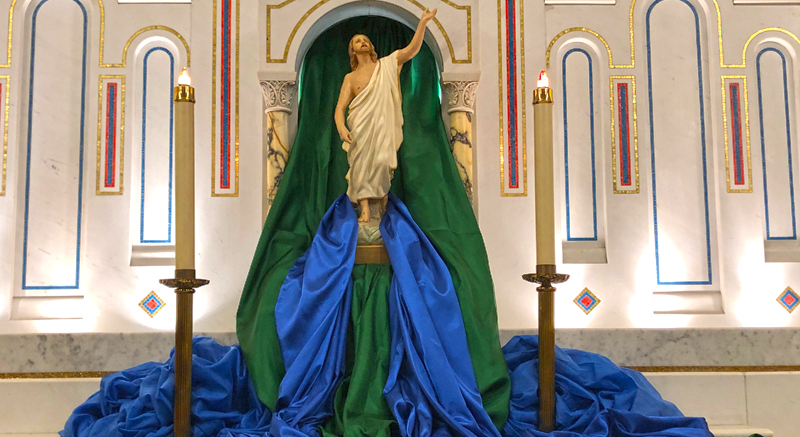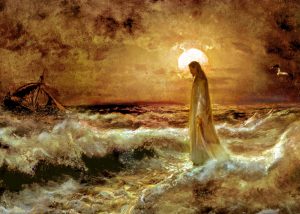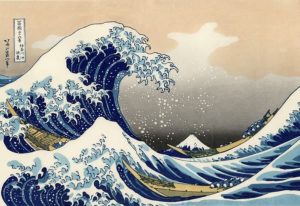Call to worship
God is always with us — in the gentle breezes that blow through our lives and in the storms that ravage us and cause anxiety. Faith in God always brings us courage, comfort and healing. Even when we step out in weakness, Jesus always is ready to lead us toward deeper revelations about ourselves, our discipleship and our blessedness.
-
To the point: The unfolding series of events in this gospel brings into sharp contrast divine action and human response, divine trustworthiness and human doubt, divine power and human weakness. When these contrasts clash, those who give themselves over to divine action are saved; those who rely on their own human response face death. This clash is evident within Peter: when he looks to Jesus and trusts him, he walks on water; when he looks away from Jesus to the frightening wind and waves, he begins to sink. All Jesus’ disciples must contend with this inevitable clash. We all must choose where to look. Where we choose to look is a matter of Life or death.
-
Connecting the Gospel (Matt 24:22-33) to the first reading: While God’s power is manifested in acts of nature (first reading: wind, earthquake, fire), Elijah recognizes God’s Presence in the “tiny whispering sound.” In the gospel, the power and Presence of God are fully revealed in the person of Jesus (“Son of God”).
-
Connecting the Gospel to experience: People often discover God in nature: the grandeur of the Grand Canyon, the vastness of the oceans, the delicacy of a rose. But our Christian faith invites us to recognize an even greater Presence of God in the person of Jesus, and our discipleship urges us to look to him for power, invitation, and salvation.
Centering prayers
The Gospel
(Matthew 14:22-23)
Meanwhile the boat … was being tossed about by the waves, for the wind was against it. … He said, “Come.” Peter got out of the boat and began to walk on the water toward Jesus.
Lord, we see you
walking on our sea,
raging with an out of control pandemic,
racial injustice and an environmental crisis.
You call us to come to you.
Help us keep our eyes on you; never take them off.
We know you will be right with us,
calming our rampant squalls.
And reach out your hand,
like you did to Peter,
if, when we are terrified,
we falter and start to sink.
The First Reading
(1 Kings 19: 9a, 11-13a)
“After the fire there was a tiny whispering sound …”
Lord, you are almighty,
too much for our eyes to see.
We find your shadow in the sunrise,
or in the workings of justice,
or your whispering in a child’s laugh,
or a Bach fugue.
You are present in family, near and far;
in good friends; in a Van Gogh;
in the beauty of wheat fields
or in wild geese winging away.
Oh, thank you for your gifts, Lord.
The Second Reading
(Romans 9:1-5)
“I have great sorrow and constant anguish in my heart.”
Father, let none of us
ever be cut off from Christ!
We thank you, and praise you
for the adoption, the glory,
the law, the worship, the promises, the covenants
you have given to the world
through your people, the Israelites.
We thank you and praise you
for the gift of your Spirit to all your people.
Copyright © 2020, Anne M. Osdieck
The Late Swallows by Frederic Delius (1916)
Another impressionistic piece of music that depicts the great presence of God in the soft wind.
(Claude Debussy)
An ambitious work, modern and original, “La Mer” by Claude Debussy received little recognition during the composer’s lifetime. Today, however, this is a different story. Often performed in concert, it is one of the composer’s most famous and greatest works.
It was in Bourgogne, in Bichain, far from the waves and the ocean, that Claude Debussy began composing La Mer, Trois esquisses symphoniques during the summer of 1903. In only two years the work is completed.
Debussy was only 8 years old when he first discovered the sea. In 1870, before the Franco-Prussian war rocked the French capital, Victorine Debussy took her children to visit her sister in law Clémentine in Cannes. The young Claude kept a fond memory of his trip to the Côte d’Azur. As the years went by, however, he developed a preference for the Channel and the Atlantic Ocean.
His link to the sea does not stop there: his father wanted more than anything for his son to be a sailor!
“Only the randomness of life made me branch off. I’ve nevertheless preserved a sincere passion for her. You’ll tell me that the ocean doesn’t exactly wash the hillsides of Burgundy. … And that this could well turn out like some studio landscape! But I have countless memories: that’s better, to my mind, than a reality whose charm generally weighs too heavily on one’s consciousness,” wrote Debussy to André Messager shortly after having put to paper the first notes of La Mer, in September 1903.
Though Debussy never explicitly described the work as such, it is nonetheless hard to deny that La Mer strongly resembles a symphony. Firstly, the work is divided into three sections. “De l’aube à midi sur la mer” resembles the traditional first movement of a symphony with its slow introduction, two main themes and a coda. As for “Jeux de vagues”, it borrows from the scherzo, and “Dialogue du vent et de la nuit” is in the form of a rondo.
“It has been said, and it must be said again: La Mer is a ‘symphony’, the only one of its author.” (François-René Tranchefort, Guide de la musique symphonique)
Debussy wanted to become a painter
The work is unquestionably pictorial in nature. One need only consider its subtitle “trois esquisses symphoniques” (three symphonic sketches). Drawn by art and painting since his youth, Debussy often told his friends he would have liked to be a painter… But it was not to be! Nevertheless, though he never learned to handle a brush, he knew how to use musical notes.
Furthermore, the composer asked that “The Wave” by Japanese engraver Hokusai be used as a cover for the score. According to Ariane Charton, La Mer draws its influences from “Monet, Turner, and Hokusai.”
“The Wave” by Japanese engraver Hokusai


















